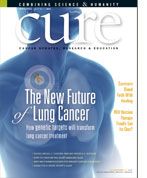Publication
Article
CURE
A How-To for the Social Media Beginner
Author(s):
Guide for the social media beginner.
Social websites seem to have almost as many uses as they do users: Their popularity stems in part from being able to adapt site features to achieve each person’s individual goals of communicating and networking. The trick is to figure out your goals for social media, and then which site will best help you meet them.
General social networking sites, like Facebook (www.face?book.com) or MySpace (www.myspace.com), are a convenient way to keep up with friends, relatives, and others, and to post your own updates—either cancer-related or not. One big advantage: Many people you know are likely already on Facebook or MySpace, so they’re easy to connect with and can even help you get started.
Among their features, these sites have ways to message friends as individuals or a group, start blogs, and find other people with the same interests or concerns.
While such websites allow lengthy communications, another popular site, Twitter (www.twitter.com), is designed for people to stay connected via brief, frequent text dispatches—“tweets”—posted to the user’s profile or blog and sent to followers. And for communicating visually, YouTube (www.youtube.com) and Flickr (www.flickr.com) offer an easy way to share video and photos online.
The web also offers social sites tailored to cancer patients, such as the American Cancer Society’s Circle Of Sharing (www.cancer.org/circleofsharing). The site aims to help people get personalized information about their disease; to share that information; and to organize their medical data and navigate treatment.
Other sites, including Lotsa Helping Hands (www.lotsahelpinghands.com), CaringBridge (www.caringbridge.org), and Share the Care (www.sharethecare.org), help caregivers and patients send out medical updates, round up child care or rides to doctors’ offices, and more.
A host of networking sites focus on specific segments of cancer patients. For instance, Planet Cancer (www.planetcancer.org) aims at young adults with cancer, and the Young Survival Coalition (www.youngsurvival.org) helps young women with breast cancer. Networking features can also be found on sites like the Leukemia & Lymphoma Society Community (community.lls.org) and the Colon Cancer Alliance’s My CRC Connections (www.ccalliance.org).
Most sites offer various levels of privacy protection to keep strangers from viewing your information. Nevertheless, be sure not to post anything you wouldn’t want made public.
To get started on a particular site, look for links like “help,” “support,” or “tour” to learn more. Also, check your local (or online) bookstore for books explaining the growing number of social media sites.

2 Commerce Drive
Cranbury, NJ 08512
All rights reserved.





